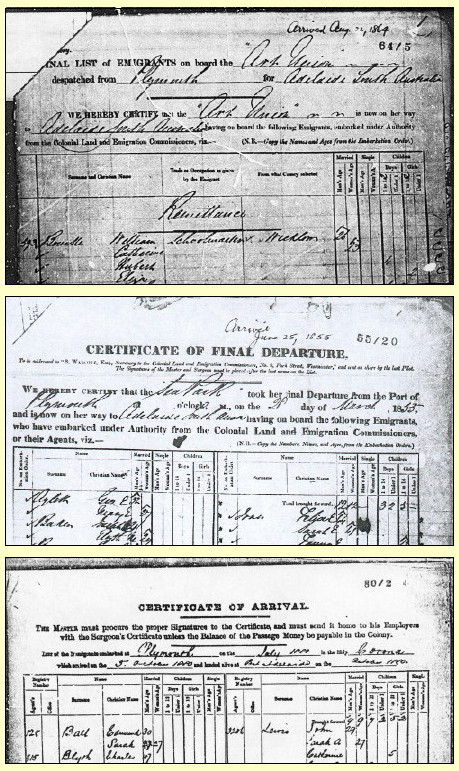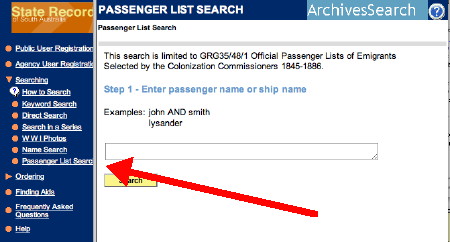
September seminars
10: Cops, crooks and victims (SA Police in the 1840s), Park Holme Library 10:30am
13: Climbing the genealogy barriers, State Library for Flinders University 9:30am
21: Genealogy on the Web, West Torrens Public Library 1:30pm
See the seminar program for more details.
Office closed
Adelaide Proformat will be closed from 27 Sep to 27 Oct.
Newspaper digitisation
The Australian Newspapers Digitisation Program that will initially be digitising approximately three million pages over four years commenced in July 2007. The web site will cover a range of titles from every state and territory, from the earliest newspaper published in Australia in 1803 through to the mid 1950s.
As part of the project work has started on the South Australian Advertiser. You can view the first pages from mid-1858 to 1861.
Understanding SA shipping records 1
To understand how immigration to South Australia worked in the nineteenth century and what records were generated empowers the researcher's search for material.
Essentially people arrived in several differing ways:
• as government assisted emigrants mainly from the UK and a few from Europe
• as recipients of fare assistance from an NGO
• as fee paying passengers mainly from the UK and Europe
• from another colony via coastal vessel
• overland from the eastern colonies
• as discharged ship crew
• by deserting their ship whilst in port
In this article we are addressing the first two listed avenues and the last two in the list were addressed largely in the article in newsletter #28.
News
September seminars
Office closed
Newspaper digitisation
Feature article
Understanding SA shipping records 1
![]()
Adelaide
Proformat
5 Windana Mews
Glandore SA 5037
Australia
Tel: +61 8 8371 4465
Fax: +61 8 8374 4479
proformat@jaunay.com
Services
• Research
• Drafting charts
• Locating documents
• Seminar presentations
• Writing & publishing
• SA lookup service
• Ship paintings
Proformat News acknowledges the support by ![]() AWE
AWE
To understand the records we need to understand the process involved
in migrating to South Australia. Once a family had resolved to emigrate,
they had two options—pay for their passage or seek financial assistance.
If they were wealthy enough to pay their own passage there may be no surviving
record of their passage. This is because at the time citizens of the British
Empire were free to travel within the Empire and the paperwork to do so
was no more onerous than buying an interstate airline ticket today! Such
travellers may appear on official passenger lists but these lists have
a very poor survival rate indeed as far as South Australia is concerned.
To determine the travel of your wealthy ancestors may require broadening
your search beyond shipping records. You would be well advised to check
the following material:
• Newspapers
• Other published material
• Institutional admissions registers
• Other government records
These avenues of research will be expanded in the third instalment on
this topic.
When it comes to government assisted passage the issue is much more complex
although the records are much more likely to be available. This is the
material often incorrectly called passenger lists when in fact they are
really accounting records associated with government assistance. That
is why they do not list the paid passengers. These records are generated
by different bodies for differing purposes and usually include:
• an embarkation list prepared by the agent or
emigration agents—called a nominal list and handed to the ship's
master at embarkation
• a passenger manifest prepared by the captain—called
a certificate of final departure and handed to the last pilot on leaving
UK waters. (Technically this document remained in the UK.)
• a certificate of arrival prepared for the immigration
officials—called a certificate of arrival.
• sundry lists created for other purposes such
as fee-payers, land-holders
For many voyages, none of this material survives and for a few, all survive.
Image 1:
The Nominal List for Art Union's 1864 voyage from Plymouth to
Adelaide.
Note the SA State Library original numbering stamp 64/5 meaning the fifth
such list for 1864. The State Library still holds copies but the originals
are now at SA State Records: GRG 35/48a.
Image 2:
Certificate of Final Departure for the 1855 voyage of Sea Park from Plymouth
to Adelaide.
Note this document is numbered 55/20.
Image 3:
Certificate of Arrival for the 1880 voyage of the Corona from Plymouth
to Adelaide.
Not all listed on the nominal list necessarily departed and not all those
on the final departure list obviously arrived in South Australia. The
Nominal List gives marginally more detail than the other lists with occupation
and county of origin being named and so we know William Bourke age 26
was a schoolmaster from Co Wicklow (see the top image above) but that
is as precise as we can expect and so if you are seeking out passenger
lists to determine a person's precise origins you will be unsuccessful
except for those free passengers arriving before 1842 where a full address
at the time of application is included in the Register of Emigrant
Labourers Applying for a Free Passage to South Australia 1836-1841
AJCP CO 386/149-151.
To have some understanding why your ancestors emigrated at a particular
time it is important to understand that the assistance scheme was not
a single scheme but a series of schemes over time with differing emphases
on what type of emigrant was required in the colony. In summary the schemes
that operated were:
1.1836–1839: SA Colonisation Commissioners selected emigrants nominated by land purchasers in England. Scheme was funded from the purchase of land. Adults free; children aged 1–7 £3; aged 8–15 £5The free passengers arriving in phases 1 and 2 of this process are those listed in the Register of Emigrant Labourers Applying for a Free Passage to South Australia 1836-1841. The names of these are available on the CD, Sources for South Australian Shipping Records 1836 to 1842 apart from naming all the emigration applicants, this CD lists all the sources of records for each of the 1500 voyages into SA in this period. Information listed gives the vessel name and voyage details, the sources, and a listing of passengers. You can check out the index online. The CD is available from Gould Genealogy and SAGHS. You can also find hard copy versions at SA State Library, State Records of SA and SAGHS. There are other records held by State Records with copies at the other named repositories covering this era that may name the passenger sought. GRG 56/68/5: Lists of passengers arriving in SA from overseas ports 1836–1845 collates records from a range of sources including newspapers. GRG 56/68/52: Miscellaneous passenger lists Oct 1837–Jul 1839 is a collection of a few of the passenger lists from that period compiled from a range of sources. GRG 41/8: Manifests of incoming ships at Port Adelaide with lists of passengers and crew Feb 1838–Apr 1842 were records maintained by customs and sometimes passengers are named.
2. 1840: Colonisation Land & Emigration Commission select agricultural labourers
June 1840–1845: Assisted emigration suspended due to lack of funds
3. 1845–1848: Colonisation Land & Emigration Commission [CLEC] selects agricultural labs, domestic and farm servants, county mechanics, and miners; married adults U40; boys 14–18; single women all £1; single men £2; children age 1–14 10/-; number of single men on vessel must equal single women.
4. 1848–1851: CLEC Free and Assisted schemes; some employment categories free; children aged 1-13 free for first 3 chn then £7 ea; age 14–40 £5; age 41–50 £7; age 51–60 £9; age 60+ £14; Irish and English female orphans as selected by Poor Law Unions who pay £5 per orphan
5. 1852–1862: Nominated by purchasers of Crown Lands; 1 free passage for every £80 of land purchased (ie 1 section) subsidised by existing settlers; priority given to agricultural lab/servants: age U40 £4; age 40+ £6; age 50+ £12; others: age U40 £8; age 40+ £8; age 50+ £12; Rates varied over the period.
1857 Land Fund closed and General Revenue used
6. 1862–1867: Selected by SA Agents and placed on vessels chartered by CLEC; nominated by colonists; men £4; women £3
July 1867–1872: No scheme
7. 1873–1876: As for 1862–1867
8. 1877–1879: Two year bond to remain in South Australia gainfully employed or £20 fine
1879–1880: No scheme
9. 1881–1883: As for 1862–1867
1883: Existing contracts only honored
1886–1899: No scheme
South Australia Index 1836–1845 an alphabetical list by surname and the given name or initial matched to a voyage. This index can be seen at State Records [SASR] and SA Genealogy & Heraldry Society [SAGHS] library, but the complete collated collection is only available at the State Library [SLSA]. However, the original records may be elsewhere. Original records with a reference GRG and RN are at SASR while the others are at the SLSA. The key to the index is in the back section of the book where all 67 sources are listed.

Assisted phases 3 to 9 passenger names are indexed and available online at State Records of SA. Just open the side menu labelled searching and select Passenger List Search. Hard copies are also available along with the actual lists at the repositories listed in the above paragraph.
Technically this online search uses GRG 56/68/3 and is an index of GRG 35/48a: List of passengers selected by the Colonisation Commissioners 1847–1886. Concurrent with these records is the indexing of names located in newspapers, GRG 56/68/7: Index of persons arriving in SA from overseas as recorded in the Adelaide Times, South Australian and SA Register newspapers. There are also indexes available at State Records and the other named repositories for the period after 1886 when no government assistance was available. Look for GRG 41/34: List of passengers arriving in SA from overseas 1888–92; 1894; 1896–1940.
The latter phases of arrivals where migration is linked to land means that records developed by the Crown Lands & Immigration Office should also be sought out. These are at State Records:
• GRG 7/39: Index to free colonial nominees—UK and Europe 1876–1879
• GRG 7/44: Index to free colonial nominees—UK and Europe 1876–1879
• GRG 7/47: Application for full passage 1873–1883
• GRG 7/40: Monthly schedule of free immigration certificates 1876–1879
• GRG 7/42: Certificates of nomination for a free passage to SA 1876–1878
• GRG 7/43: Certificates of nomination for a free passage to SA from Europe 1876–1879
• GRG 7/45: Applications by residents of SA for assisted passage for residents of the UK & Europe 1881–1883
• GRG 7/48: Notice of intention to pay balance of passage money 1883
• GRG 35/1: Correspondence of the Crown Lands & Immigration Office 1856–1917. Indexes GRG 35/23 and GRG 35/24
• GRG 44/40: Receipt for Land Orders 1874–85 (issued to those paying full passage)
• GRG 35/407:Land Order warrants 1880–85 (issued to those holding a Land Order on arrival)
Some passengers may be located in the following series:
• GRG 35/48: Immigrant ships' papers 1849–67, 1873–85 (selected passengers were on the payroll)
• SA Govt Gazette Jan 1866 pp75–96: Deaths on board Emigrant ships 1849–1865
Another group of emigrants received assistance from the SA government and other sources and these will be addressed in the next issue of this newsletter.
newsletter-leave@jaunay.com